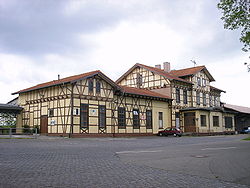Ohrdruf
| Ohrdruf | ||
|---|---|---|

Railway station
|
||
|
||
| Coordinates: 50°49′41″N 10°43′58″E / 50.82806°N 10.73278°ECoordinates: 50°49′41″N 10°43′58″E / 50.82806°N 10.73278°E | ||
| Country | Germany | |
| State | Thuringia | |
| District | Gotha | |
| Government | ||
| • Mayor | Marion Hopf | |
| Area | ||
| • Total | 39.75 km2 (15.35 sq mi) | |
| Population (2015-12-31) | ||
| • Total | 6,218 | |
| • Density | 160/km2 (410/sq mi) | |
| Time zone | CET/CEST (UTC+1/+2) | |
| Postal codes | 99885 | |
| Dialling codes | 03624 | |
| Vehicle registration | GTH | |
| Website | www.ohrdruf.de | |
Ohrdruf is a small town in the district of Gotha in the German state of Thuringia. It lies some 30 km southwest of Erfurt at the foot of the northern slope of the Thuringian Forest.
Ohrdruf was reportedly founded in 724–726 by Saint Boniface, as the site of the first monastery in Thuringia, dedicated to Saint Michael. It was the first of several religious foundations in the town, the latest of which is the Carmelite monastery Karmel St. Elija (founded 1991).
In 1550, under Georg II von Gleichen work began on Schloss Ehrenstein at the site of the former 8th century monastery.
During the 17th century, the Schloss fell to the Grafen von Hohenlohe who after 1760 made alterations to it in Baroque style.
In 1695, the orphaned Johann Sebastian Bach came to live and attend school at Ohrdruf, under the care of his older brother Johann Christoph Bach (1671–1721), who had come here in 1690 as organist at the St. Michaelis Kirche (St Michael's Church) and as a teacher at the Lyceum. Johann Sebastian lived in Ohrdruf from the ages of 10 to 15.
In the 19th century, the town became a centre of toy manufacturing. The Kewpie doll was produced here from 1913. There are still some old molds embedded in the facades of Ohrdruf buildings.
In 1869, the Hohenlohe family sold the Grafschaft Gleichen including the castle and town of Ohrdruf to the Duchy of Saxe-Gotha.
...
Wikipedia




